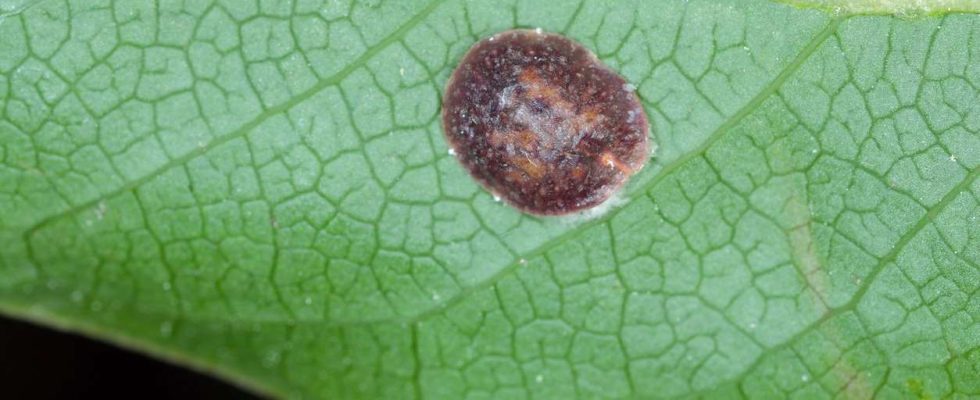
Learn more about black cochineal to better eliminate it
Description of the black olive mealybug
From the Coccidae family and known under the scientific name of Saissetia oleae and the name of lecanin mealybugthis cochineal originating from South Africa and imported into our territory through trade is characterized by a convex body hardened by waxy secretions, 2 to 4 mm long, 1 to 4 mm wide and with a thickness of 2 at 2.5mm.
This body is protected by an easily recognizable shield with its H drawn on it in relief. Chestnut brown in color at the start of its life, the olive mealybug turns dark brown as it ages. To feed itself, this cochineal, like the others, prick the leaves to extract the sap.
Life cycle of the black mealybug
The black olive mealybug reproduces by parthenogenesis, that is, there are no males, it is a kind of self-fertilization. Females lay hundreds of eggs, 0.3 mm long, whitish or orange-pink in color under their shield.
The laying of black mealybugs lasts throughout the summer. The eggs hatch 2 to 3 weeks later to give birth to larvae which will go through 3 stages before becoming adults:
- 1st stage : the larva is pink and oblong in shape. It is still quite mobile, which means that the multitude of larvae will disperse and they will then go and colonize other plants where they will attach themselves to the young branches or the underside of the leaves which they will prick to Eat.
- 2nd stage : the larvae have become small scale insects 1.5 mm long, light brown in color and elongated in shape. They spend the winter in this form.
- 3rd stage : in spring, they move on to stage 3 of their life and transform into young, darker-colored females. Around mid-June, they are adults and take on a black color. They are then ready to lay eggs under their shield and a new cycle can begin.
From September onwards, we can observe different stages of larvae, even a few young adults. If the autumn conditions are mild, they will be able to give birth to a second generation.
Signs that should alert you
As we have seen, black mealybugs are biting-sucking insects which, during their 1st larval stage, settle on a tree to feed on its sap. This is not without consequences for the tree concerned, but certain signs should alert you:
- Modification of the tree: by taking large quantities of sap, the mealybug colonies weaken the tree. This is manifested by yellowing of the leaves, a general weakening of the tree and a cessation of its growth. In extreme cases, if mealybugs swarm, the infested plant can even die. This is especially visible on trees grown in pots.
- Honeydew: the presence of a sweet, sticky substance adhering to the leaves of the tree should also alert you. This is honeydew which is produced by mealybugs.
- Ants on the tree: As honeydew is very popular with ants, your tree can also be invaded by ants.
- Sooty smoke: your eye may also be drawn to dark gray or black-brown clumps on your tree’s leaves. This is sooty mold, a microfungus which, by growing on honeydew, contributes to a significant reduction in photosynthesis.
Sensitive plants
The black olive mealybug is, unfortunately, a polyphagous insect pest. This means that it can attack plants other than the olive tree. Those that are favored are essentially fig trees, citrus trees, apricot trees, pittosporums, oleanders, ivies.
Prevent the appearance and proliferation of black mealybugs
Prevention involves the following few habits to adopt:
- It is necessary to regularly monitor your olive trees in order to quickly spot the signs that we have described above and which can be indicative of the presence of black mealybugs. This vigilance will allow you to deal quickly, if necessary. As soon as scale insects appear, you can remove the infested parts of the plants by hand.
- Ensure the good health of your tree(s). This requires proper pruning of the foliage to ensure good air circulation and avoid excess humidity.
- Reduce fertilizationbecause an excessive supply of nitrogen risks causing the proliferation of mealybugs.
- Also be careful not to overwater to limit their presence. Excess humidity favors the presence of mealybugs.
- Clean your gardening tools carefully to avoid any risk of transmission of diseases or larvae from one plant to another.
- With this same objective, be sure to prune branches which affect other plants. This helps avoid bridges between plants.
- Refrain from using pesticides which could harm natural predators of mealybugs, such as ladybugs, in addition to being harmful to the environment.
Fight against black olive mealybug
To combat mealybugs, several solutions are available to you:
- Homemade recipe: it is possible to prepare a mixture based on water, black soap and olive oil to spray over the entire plant, taking care not to neglect the front and back of the leaves, nor the surface of the substrate nor the stems and trunk. You can also wipe a cloth dampened with this mixture over each leaf to remove the honeydew from the plant. This treatment, whether spraying or using a cloth, must be repeated until the mealybugs completely disappear.
- Multipurpose plant insecticide: in case of serious infestation, you can use an insecticide based on rapeseed oil.
- Ladybugs : you can introduce comma ladybugs into your garden.

